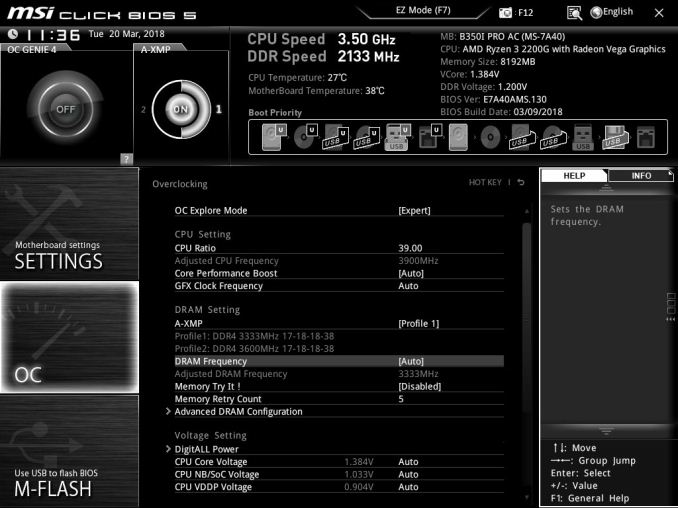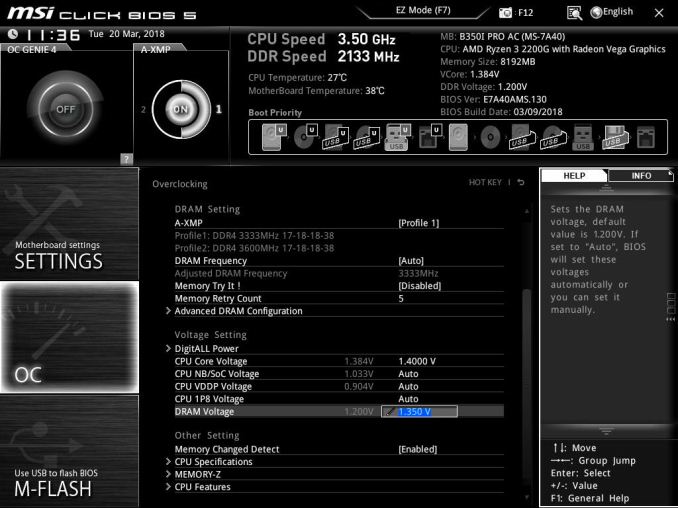AMD Ryzen 5 2400G and Ryzen 3 2200G Integrated Graphics Frequency Scaling
by Gavin Bonshor on September 28, 2018 12:30 PM EST- Posted in
- CPUs
- AMD
- GPUs
- Overclocking
- Zen
- APU
- Vega
- Ryzen
- Ryzen 3 2200G
- Ryzen 5 2400G
Overclocking Ryzen APU Integrated Graphics
As we detailed in our dedicated AMD Ryzen 2000 series APU overclocking guide and analysis, both the Ryzen 5 2400G and the Ryzen 3 2200G chips benefit from overclocking the CPU core frequency. The results on heavy computational workloads gave noticeable improvements across the board, while the gaming results didn't seem to have the expected 'oomph' so to speak. When it comes to overclocking the integrated graphics, the key directive and conclusion is that when a user is overclocking the CPU core frequency, it lessens the headroom available to overclock the integrated graphics and visa versa. It is a real push and pull situation.
Overclocking the integrated graphics on the MSI B350I Pro AC motherboard was quite easy as there are three main variables to consider.
- The graphics clock frequency is the primary frequency setting, measured in MHz
- The SoC voltage (or CPU NB Voltage) is directly linked to the integrated graphics voltage.
- The CPU core frequency and CPU core voltage can also help/hinder.
Beware the Black Hole!
When overclocking the integrated graphics core on both APUs, rising through the frequencies, we experienced an anomaly or 'black hole' between 1350 and 1500 MHz. Regardless of the settings, there was a clear issue in the system.
While the system would boot at these frequencies, the combination of overclock and drivers caused random reboots of the test system, constant and consistent crashes during gaming, and Windows Crash Reporter stating a 'Video_TDR_Failure' of the atikmpag.sys process. This error is usually an indication of a faulty or corrupt graphics driver, but in this instance, it happened across multiple systems with three different motherboards and operating systems using the AMD's Adrenalin Edition 18.5.1 WHQL drivers (the latest at the time of testing). The issue bestowed itself regardless of the GPU driver used, or BIOS revision on any of the motherboards tested.
At 1500 MHz however, the issue went away. Our experience is not unique - other professionals in the industry have experienced similar issues. We have reached out to AMD about this issue and will update when an official response is received.
Overclocking Results
The Ryzen 5 2400G has a base graphics frequency of 1250 MHz and the Ryzen 3 2200G has a base frequency of 1100 MHz. We were able to push both of them up to 1600 MHz, giving a 28% and 45% overclock respectively. For the completeness of data, we ran both APUs from 1100 MHz up to 1600 MHz, missing out the black hole. Here were our settings:
| Integrated Graphics Frequency | SoC/iGPU GFX Voltage |
| 1100 MHz | 1.15 V |
| 1150 MHz | 1.15 V |
| 1200 MHz | 1.15 V |
| 1250 MHz | 1.15 V |
| 1300 MHz | 1.15 V |
| 1350 MHz | 1.15 V |
| 1400 MHz | ERROR |
| 1450 MHz | ERROR |
| 1500 MHz | 1.20 V |
| 1550 MHz | 1.25 V |
| 1600 MHz | 1.25 V |












49 Comments
View All Comments
neblogai - Saturday, September 29, 2018 - link
Or a €10 Deepcool Gammaxx 200T, €15 Gammaxx 300, etc.lightningz71 - Saturday, September 29, 2018 - link
If you keep the overclock reasonable. Keep the CPU stock and push the iGPU to 1600mhz. If you push higher, it starts demanding a lot of SOC voltage, which hurts the memory controller performance. There are a few B450 boards with decent 2 phase SOC sections that would be fine there. The problem is having the option in the BIOS to actually overclock the iGPU.dromoxen - Sunday, September 30, 2018 - link
I dont think ppl are are able to push higher, 1600mhz seems to be pretty much the outer limit. It appears that the greatest increase is going from 1100mhz to 1150mhz after that the gains are much less. Power draw and heat would be nice to know . I would like to have one of these in a nuc style system as a tellybox maybe the ge's will suit better. They can only get more popular if Intel cant supply Budget chips for next 9 monthseastcoast_pete - Saturday, September 29, 2018 - link
Gavin, thanks for this last chapter of the Zen APU reviews! As mentioned by others here, it would be helpful if you could post the power draw (even just overall) figures; they usually give a good idea how much of a sweat the silicon works up. The other point is that if I would OC either the CPU or GPU on a 2200G or 2400G, I would at least try to OC the memory a bit, too. With graphics likely limited by memory speed, that seems to be a logical thing to try. If you did, any information on that combo (OC'd graphics plus OC'd memory) would be appreciated! It doesn't have to be a full list of all OC permutations.ballsystemlord - Saturday, September 29, 2018 - link
You wrote the wrong APU name down in the paragraph reading "Performance in Shadow of Mordor wasn't the best we have seen from the game testing, with average framerates gradually increasing on the 2400G."You were testing the 2200G in that section.
I know it's easy to make that mistake, I do it too.
Haawser - Saturday, September 29, 2018 - link
"For any compute related workloads, the integrated graphics frequency is ineffective whereas pure MHz on the Ryzen cores and memory frequency can play a major part in improving performance throughput. "Implying that memory overclocking isn't useful for graphics too ? Why didn't you try overclocking the graphics *and* memory, seeing as both are easy to do ? And 90% of APU users interested in gaming will anyway ?
eva02langley - Saturday, September 29, 2018 - link
I am having a similar motherboard, the MSI B450i Gaming AC plus, and the same behavior between 1350-1400MHz happen.I just put the iGPU at 1500MHz with 1.2V and it is running flawlessly in games.
Also, I am experiencing strange blinking black screen once in a while. It is like a blinking of an eye. It is kind of annoying.
Do you experience the same thing?
wilsonkf - Sunday, September 30, 2018 - link
Why don't you test at least one more faster memory speed (e.g. 3466Mhz)? This would be interesting.hashish2020 - Tuesday, October 2, 2018 - link
I hope that they end up doing that, because that will likely be the sweet spot for casual gamers like me who are thinking about getting back into building desktops.lightningz71 - Tuesday, October 2, 2018 - link
The memory controller on the 2400G is not improved over Zepplin in any measurable way. It gets unstable quickly past 3200/3333 (though, with very loose timings and good samples, there are OC examples in the 3400 range, though, stability is questionable.)Buildzoid on reddit has a video on testing. He showed that B-die can net you tight timings at 3200/3333/ but gets VERY hot above that. E-Die was showing stability and lower temperatures at 3400, but, the timings were looser to get there. No matter what, his performance testing showed that 3200/3333 with tight timings were just as fast as 3400 with loose timings, and more achievable. His absolute fastest times were with UNSTABLE runs of B-Die at 3400+ mhz with passable timings, but it required considerable cooling to occasionally complete a test.
The advantage to keeping the memory at 3200/3333 with tight timings is that you can run a bit more SOC voltage and maybe get a bit more out of the iGPU. 1600 is a reasonable overclock, but, with a bit more voltage, people are getting it past 1650 and sometimes 1700.
I haven't seen delidding results on iGPU overclocking with memory overclocking at the same time.